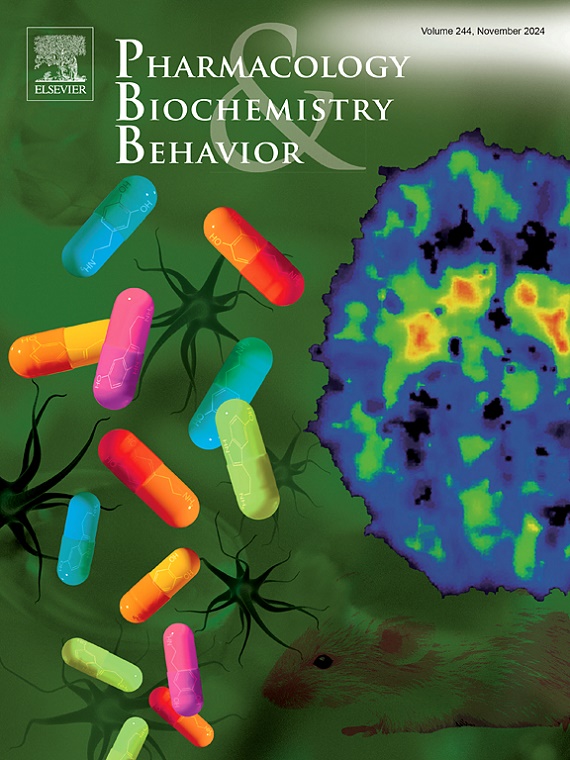Divergent effects of noradrenergic activation and orexin receptor 1 blockade on hippocampal structure, anxiety-like behavior, and social interaction following chronic stress
IF 3.3
3区 心理学
Q1 BEHAVIORAL SCIENCES
引用次数: 0
Abstract
Chronic stress (Ch.S) has detrimental effects on the brain's structure and function, particularly in the hippocampus. The noradrenergic and orexinergic systems play crucial roles in the stress response and regulation of stress-related behaviors. This study aimed to investigate the interaction between noradrenergic activation and orexin receptor 1 inhibition on chronic stress-induced hippocampal alterations.
The study conducted experiments on male Wistar rats, subjected to Ch.S, OXr1 blocking, noradrenergic activation, or a combination of these treatments. Plasma corticosterone level was measured using a fluorometric method. Behavioral assessment of social maze, elevated plus maze (EPM) and novel object recognition (NOR) test were performed. Then, the expression of prepro-orexin, OXr1, and glucocorticoid receptor (GR) was analyzed using semiquantitative RT-PCR. Neuronal populations were quantified through Nissl staining.
The data revealed that all stress and yohimbine groups had elevated plasma corticosterone levels. Ch.S significantly altered behavior, impairing social interaction, disrupting object recognition memory and increasing anxiety-like responses in the EPM. OXr1 blocking reversed these stress-induced behavioral deficits, while yohimbine did not improve these behavioral outcomes. Chronic stress led to a significant increase in prepro-orexin, OXr1, and GR expression. While blocking OXr1 helped counteract these stress-induced changes, yohimbine failed to restore the expression levels. Ch.S reduced hippocampal neuronal populations, while OXr1 blocking partially reversed this effect, and yohimbine further recovered the reversal.
These findings indicate that blocking hippocampal OXr1 can mitigate the adverse effects of chronic stress on both hippocampal structure and anxiety-like behaviors, while noradrenergic signaling appears to have differential effects on behavioral and cellular measures.

慢性应激后去甲肾上腺素能激活和食欲素受体1阻断对海马结构、焦虑样行为和社会互动的不同影响
慢性压力(chs)对大脑的结构和功能,特别是海马体有不利影响。去甲肾上腺素能和增氧能系统在应激反应和应激相关行为的调节中起着至关重要的作用。本研究旨在探讨去甲肾上腺素能激活和食欲素受体1抑制在慢性应激性海马改变中的相互作用。该研究对雄性Wistar大鼠进行了实验,分别进行了chs、OXr1阻断、去甲肾上腺素能激活或这些治疗的组合。采用荧光法测定血浆皮质酮水平。进行社交迷宫、高难度迷宫(EPM)和新目标识别(NOR)测试的行为评估。然后,采用半定量RT-PCR分析pre - pro-orexin、OXr1和糖皮质激素受体(GR)的表达。通过尼氏染色定量神经元群体。数据显示,所有应激组和育亨宾组血浆皮质酮水平均升高。chs显著改变了行为,损害了社会互动,破坏了物体识别记忆,增加了EPM中的焦虑样反应。OXr1阻断逆转了这些应激诱导的行为缺陷,而育亨宾没有改善这些行为结果。慢性应激导致pre - pro-orexin、OXr1和GR表达显著增加。虽然阻断OXr1有助于抵消这些应激引起的变化,育亨宾未能恢复表达水平。Ch.S减少海马神经元数量,而OXr1阻断部分逆转了这种作用,育亨宾进一步恢复了这种逆转。这些发现表明,阻断海马OXr1可以减轻慢性应激对海马结构和焦虑样行为的不利影响,而去甲肾上腺素能信号似乎对行为和细胞措施有不同的影响。
本文章由计算机程序翻译,如有差异,请以英文原文为准。
求助全文
约1分钟内获得全文
求助全文
来源期刊
CiteScore
6.40
自引率
2.80%
发文量
122
审稿时长
38 days
期刊介绍:
Pharmacology Biochemistry & Behavior publishes original reports in the areas of pharmacology and biochemistry in which the primary emphasis and theoretical context are behavioral. Contributions may involve clinical, preclinical, or basic research. Purely biochemical or toxicology studies will not be published. Papers describing the behavioral effects of novel drugs in models of psychiatric, neurological and cognitive disorders, and central pain must include a positive control unless the paper is on a disease where such a drug is not available yet. Papers focusing on physiological processes (e.g., peripheral pain mechanisms, body temperature regulation, seizure activity) are not accepted as we would like to retain the focus of Pharmacology Biochemistry & Behavior on behavior and its interaction with the biochemistry and neurochemistry of the central nervous system. Papers describing the effects of plant materials are generally not considered, unless the active ingredients are studied, the extraction method is well described, the doses tested are known, and clear and definite experimental evidence on the mechanism of action of the active ingredients is provided.

 求助内容:
求助内容: 应助结果提醒方式:
应助结果提醒方式:


